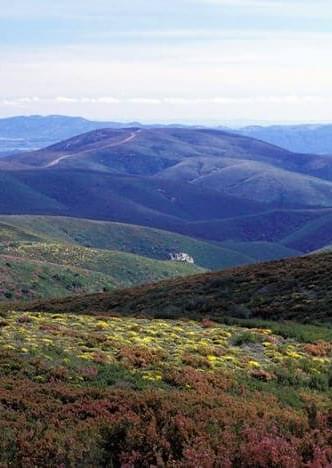The Great Route of Côa Valley is a magical 196 km-long route along the Côa river from the spring in Fóios in Sabugal to the river estuary in Douro River in Vila Nova de Foz Côa.
Its almost untouched 196 km stretch from the Malcata Nature Reserve where the black oak (Quercus pyrenaica), the strawberry tree (Arbutus unedo) and the holm oak (Quercus rotundifolia) lend many shades of green to the landscape up to the steep valley of the river already close to the Foz, where very dramatic rocky outcrops are admired from the sky by the majestic flights of Bonelli's eagles (Aquila fasciata), golden eagles (Aquila chrysaetos), the petrel (Neophron percnopterus) and the black vulture (Aegypius monachus).
Because there is a fascinating network of streams and tributaries of the river, there is also a rich mosaic of Mediterranean crops such as vines, olive groves and almond trees along the route.
And where there are almond trees as far as the eye can see, there are also circular dovecotes, built of stone and used for breeding rock doves (Columba livia), so important for the production of "pigeonpea", the most natural of fertilizers.
And the heather that also dominates the landscape of the Côa Valley, in the Malcata Nature Reserve, is followed by the white broom (Cytisus multiflorus), piorno-amarelo (Retama spherocarpa), cistus (Cistus ladanifer) and areas of bramble, with rosa-canina (Rosa canina) and blackberry (Rubus sp.).
Closer to the mouth of the river, the Faia Brava Natural Reserve, which is part of the Forest Intervention Zone of Algodres and Vale de Afonsinho, the huge cork oak forest (Quercus suber), the holm oak (Quercus rotundifolia) and the very imperial Portuguese oak (Quercus faginea) are the ones that surprise us.
And there are, to our eyes, large expanses of lavender (Lavandula stoechas) and bold strokes of thyme bela-luz (Thymus mastichina) and helichrysum stoechas (Helichrysum stoechas).
On the banks of the river, the absolutely perfect line of ash trees (Fraxinus angustifolia), lotus (Celtis australis) and poplars (Popullus sp.), is visited by many birds.
For those who are more intimate, you can see the undata warbler (Sylvia undata), the crowned godwit (Pyrrhula pyrrhula) or the golden oriole (Oriolus oriolus);
A great enchanted valley.
But along this route, there are castles like fairy tales. They are very ancient castles, strategically essential for the stability of the border between Portugal and Spain. They are all imposing: Sabugal, Vila Maior, already on the way to Almeida, there are Castelo Mendo and Castelo Bom, the magnificent Castelo de Pinhel, the Almeida Fortress, Castelo Rodrigo and Castelo Melhor.
And as if trees, birds, cranes, pigeons and precious scents were not enough, near the mouth of the river, there are thousands of engravings from the Upper Paleolithic: an absolutely unique open-air art gallery, preserved over 30,000 years and classified by UNESCO: the Archaeological Park of the Côa Valley.
Length: 196 Km
Number of stages: 11
Maximum height: 1164 m
Minimum height: 129 m
Difficulty degree: medium to very difficult
Total duration: 10 to 15 days walking; 3 to 6 days cycling
Advisable season: Spring and Autumn













